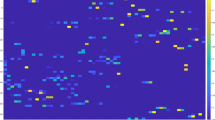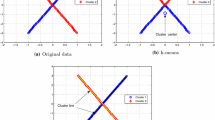Abstract
In this paper, a novel clustering method is proposed which is done by some hyper planes in the feature space. Training these hyper-planes is performed by adjusting suitable bias and finding a proper direction for their perpendicular vector so as to minimize Mean-Squared Error. For this purpose, combination of training a hyper plane and a fundamental search method named Mountain-Climbing is utilized to find a local optimum solution. The approach achieves a satisfactory result in comparison with the well known clustering methods such as k-means, RPCL, and also two hierarchical methods, namely, Single-Link and Complete-Link. Low number of parameters and linear boundaries are only some merits of the proposed approach. In addition, it finds the number of clusters dynamically. Some two dimensional artificial datasets are used to assess and compare these clustering methods visually.
Access this chapter
Tax calculation will be finalised at checkout
Purchases are for personal use only
Preview
Unable to display preview. Download preview PDF.
Similar content being viewed by others
References
Russell, S.J., Norvig, P.: Artificial Intelligence: A Modern Approach, 2nd edn., pp. 111–114. Prentice Hall, Upper Saddle River (2003)
Fawcett, T.: ROC Graphs: Notes and Practical Considerations for Researchers, Technical Report HPL-2003-4, HP Labs (2003)
Lachiche, N., Flach, P.: Improving accuracy and cost of two-class and multi-class probabilistic classifiers using ROC curves. In: Proc. 20th International Conference on Machine Learning (ICML 2003), pp. 416–423 (2003)
Zolghadri Jahromi, M., Taheri, M.: A proposed method for learning rule weights in fuzzy rule-based classification systems, Fuzzy Sets and Systems, 29 August (in press, 2007)
Zolghadri, M.J., Mansoori, E.G.: Weighting Fuzzy Classification Rules Using Receiver Operating Characteristics (ROC) Analysis. Information Sciences 177(11), 2296–2307 (2007)
Editor information
Editors and Affiliations
Rights and permissions
Copyright information
© 2008 Springer-Verlag Berlin Heidelberg
About this paper
Cite this paper
Taheri, M., Chitsaz, E., Katebi, S.D., Jahromi, M.Z. (2008). A Novel Piecewise Linear Clustering Technique Based on Hyper Plane Adjustment. In: Sarbazi-Azad, H., Parhami, B., Miremadi, SG., Hessabi, S. (eds) Advances in Computer Science and Engineering. CSICC 2008. Communications in Computer and Information Science, vol 6. Springer, Berlin, Heidelberg. https://doi.org/10.1007/978-3-540-89985-3_1
Download citation
DOI: https://doi.org/10.1007/978-3-540-89985-3_1
Publisher Name: Springer, Berlin, Heidelberg
Print ISBN: 978-3-540-89984-6
Online ISBN: 978-3-540-89985-3
eBook Packages: Computer ScienceComputer Science (R0)




